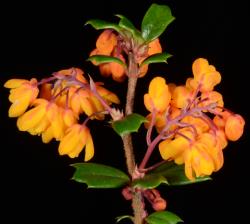- Taxon
- Weed
- Gallery
Evergreen shrub to c. 4 m high. Shoots densely clothed in brown hairs, terete or nearly so. Spines palmately 5-partite, hairy. Lvs subsessile or nearly so. Lamina 1–3–(3.5) × 0.5–1.5–(2) cm, obovate with 2 spiny apical lobes (lvs of vegetative shoots sometimes with additional spiny teeth below), glabrous, glossy dark green above; base cuneate. Infl. usually a simple pendulous raceme to c. 7 cm long, occasionally slightly paniculate. Bracts lanceolate, reddish, much < pedicels. Pedicels 5–15 mm long at anthesis, reddish. Perianth segments 5–8.5 mm long except in the much shorter outermost whorl, orange-yellow except for reddish flush on outermost segments, usually oblong or oblong-obovate; innermost whorl (petals) slightly emarginate. Nectaries inconspicuous. Stamens slightly < petals. Ovules up to 8. Style = or > ovary at anthesis. Berry 5–7 mm diam., subglobose or globose, black or nearly so, ± pruinose; fruiting style conspicuous, 1.5–3 mm long.
[From: Webb et al. (1988) Flora of New Zealand. Volume 4.]
Flowering: Jan.–Dec.




